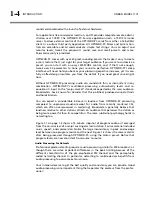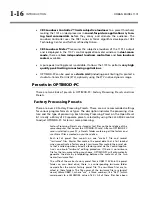
1-10
INTRODUCTION
ORBAN MODEL 1101
The J & T meter is monophonic. Psychoacoustic studies indicate that when
multiple acoustic sources are present in a room, loudness is most accu-
rately expressed by summing the power in the sources. For example, driv-
ing two loudspeakers with identical program produces 3 dB higher loud-
ness than a single speaker produces. Therefore, to extend the J & T algo-
rithm to surround reproduction, we implement one eight-filter filterbank
for each channel and compute RMS sums of the outputs of corresponding
filters in each channel before these sums are applied to the eight nonlin-
ear lowpass filters. As in the monophonic J & T algorithm, the sum of
these lowpass filters drives a second nonlinear filter, which drives the dis-
play.
The OPTIMOD-PC Digital Audio Processor
OPTIMOD-PC is a PCI card that fits in an IBM-compatible PC and processes one stereo
audio stream or two mono audio streams. It is equally suitable for netcasts and digi-
tal radio or television broadcasting. With its supplied WAVE drivers, it looks like a
standard sound card to your native applications, like the Orban’s Opticodec-PC®
MPEG-4 AAC/HE-AACv2 Streaming Encoder. However, unlike a sound card,
OPTIMOD-PC packs hundreds of MIPS of built-in DSP processing power, allowing it
to apply broadcast-quality audio processing to your netcast or digital broadcast
without loading down your computer’s CPU with DSP tasks.
OPTIMOD-PC is useful for users with multiple streams because you can load one
computer (which may be connected to a PCI expansion chassis) with as many
OPTIMOD-PC cards as you have free PCI slots, each card handling one stereo pro-
gram. Each card has two AES3 or S/PDIF digital inputs and one high-quality analog
input, all of which can be mixed—built-in sample rate converters allow digital
sources to be asynchronous. The card also offers an AES3 output and an analog
monitor output. Therefore, you can route audio through the computer’s PCI bus or
entirely independently of the computer—the choice is yours, and will depend on
your application. For example, DAB multiplexes can use multiple OPTIMOD-PC cards
to save cost and space by comparison to stand-alone processors. (The multiplexes
would use OPTIMOD-PC’s AES3 inputs and outputs, and could exploit OPTIMOD-PC’s
ability to genlock its output sample rate to the sample rate applied to either AES3
input.) OPTIMOD-PC (including the I/O mixer) is also fully remote controllable over a
network.
The rest of Chapter 1 explains how OPTIMOD-PC fits into the DAB and DTV broad-
cast facilities, and how it can be used for netcasting. Chapter 2 explains how to in-
stall it. Chapter 3 tells how to operate OPTIMOD-PC and tune it to get the sound you
want.
OPTIMOD-PC was designed to deliver a high quality sound while simultaneously in-
creasing the average level on the channel substantially beyond that achievable by
“recording studio”-style compressors and limiters. Because such processing can ex-
aggerate flaws in the source material, it is very important that the
source audio be
as clean as possible.
Содержание Optimod-PC 1101
Страница 4: ......
Страница 14: ......
Страница 121: ...OPTIMOD PC OPERATION 3 1 Section 3 Operation Figure 3 1 The OPTIMOD PC Control Application...
Страница 192: ...3 72 OPERATION ORBAN MODEL 1101...
Страница 204: ......
Страница 210: ......
Страница 212: ...5 2 UNINSTALLATION ORBAN MODEL 1101...
Страница 236: ......
















































